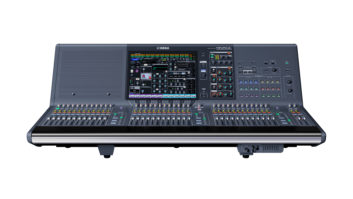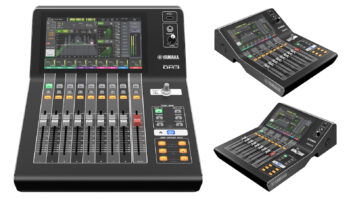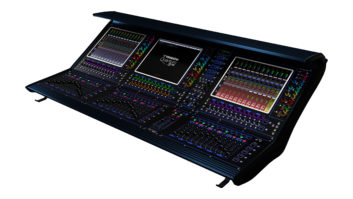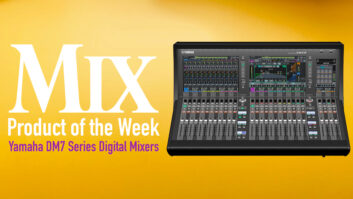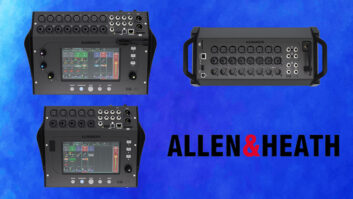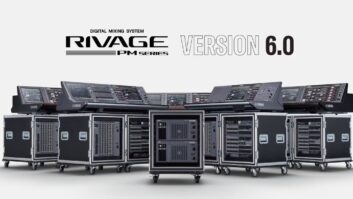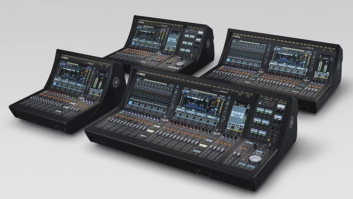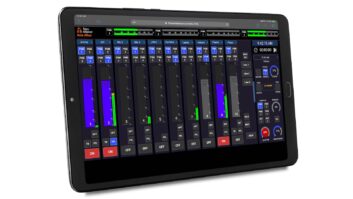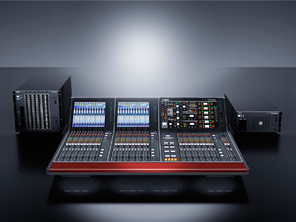
Yamaha Corporation Japan has launched the RIVAGE PM10 Digital Mixing Console, described as an evolutionary step for Yamaha PM Series Digital Live Sound Consoles. The PM10 system is comprised of the CS-R10 control surface, DSP-R10 DSP engine, RPio622 I/O rack, three types of RY cards, and two types of HY cards provide the flexibility to configure and ideally match the scale and functional requirements of any application.
More than 10 years have passed since the Yamaha released the PM1D and PM5D digital consoles. The company says its new flagship RIVAGE PM10 significantly increases the quality and versatility necessary in a live sound environment, and inherits features from the renowned PM Series Consoles.
Under the fundamental philosophy of Yamaha live sound consoles, Hybrid Microphone Preamplifiers have been newly developed, as has the analog section both in terms of components and overall design. Models of the Rupert Neve Designs (RND) transformer circuitry and acclaimed SILK processing have been created using Yamaha’s VCM (Virtual Circuitry Modeling) technology.
The SILK processing feature includes selectable RED and BLUE characteristics, and a continuously variable TEXTURE knob that facilitate sonic shaping right at the input stage, adding musical sparkle or power as required.
The channel EQ and dynamics have been significantly upgraded with three newly developed algorithms plus the classic Yamaha Legacy algorithm. The new Precise algorithm includes Q parameters on the low and high shelving filters that allow filter overshoot to be flexibly controlled for added musical impact. An Aggressive algorithm has been designed for the most musical response, and the Smooth algorithm offers smooth, natural control while retaining the fundamental character of the source. Two Dynamics stages are provided, each functioning as a gate, compressor, ducker, or de-esser as required. Two compressor types are included: Legacy Comp features standard Yamaha digital console compressor characteristics, and Comp260, a VCM model of a popular analog comp/limiter from the mid ’70s.
A total of 45 plug-ins are available for creative processing, with substantially increased processing power. New and noteworthy are plug-ins created in collaboration with Rupert Neve Designs, TC Electronic, and Eventide.
Collaboration with Rupert Neve Designs has resulted in the Rupert EQ 773, Rupert Comp 754, Rupert EQ 810, and Rupert Comp 830, all VCM models of Neve designed outboard devices from the ’70s and ’80s. All four models promise the vintage outboard sound still favored by many discerning engineers.
The alliance with TC Electronic has resulted in the inclusion of two new reverb plug-ins: the VSS4HD room simulation reverb that offers a multitude of reflection settings with musical-sounding reverb processing capabilities, and the NON LIN2 plug-in that can function as an envelope-filtered gate reverb without requiring a trigger.
Cooperation with Eventide has produced the H3000-LIVE harmonizer, an accurate reproduction of the H3000 Ultra Harmonizer algorithm with an interface streamlined for live sound use.
Console operation has been given the utmost attention with the Yamaha-familiar Selected Channel section implemented in full, allowing all parameters of the selected channel to be directly and intuitively controlled. There are also two large LCD touch screens that provide logical continuity with the faders, offering the same operability as the highly regarded Centralogic interface in 12-channel groups. In addition to this dual interface hybrid operation style, horseshoe-ring encoder position indicators, refined panel layout, and several other details contribute to significantly improved overall operability.
New features extend the usefulness of the scene memory: Isolate enables the engineer to specify entire channel modules including EQ and dynamics libraries, etc., that will be protected from recall operations without altering the Recall Safe settings; significant for situations where scene memory is heavily used. The Overlay Filter can be “overlaid” on a current mix to apply temporary offsets to fader and mix/matrix send levels independently from Scene Recall, which is valuable in situations that require sudden changes and the ability to easily revert to the original settings.
The CS-R10 control surface and DSP-R10 DSP engine are connected via a dedicated Cat-5e ring Console Network. The DSP engine connects to the RPio622 I/O racks via the newly developed TWINLANe ring network using multi-mode optical fiber. The fact that both networks use simple ring connections facilitates redundancy and the highest possible reliability. TWINLANe is an original Yamaha protocol that can handle up to 400 96kHz audio channels over distances of up to 300 meters with low latency and redundancy for high reliability. Up to two DSP-R10 DSP engines and eight RPio622 I/O racks can be connected in a single ring.
Connection to a computer for multi-track recording, connectivity to the NUAGE Advanced Production System, Yamaha CL and QL Series Consoles, as well as other external equipment is possible via a Dante network. Dante, designed for simple setup with an extremely wide range of professional audio devices, works ideally with TWINLANe to create an exceptionally flexible, reliable system overall.
RIVAGE PM10 has an expected delivery during 2015.
For more, expanded information on RIVAGE PM10, visit www.yamahacommercialaudiosystems.com/rivage.php.
